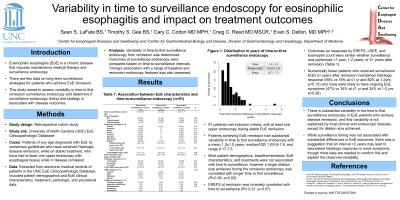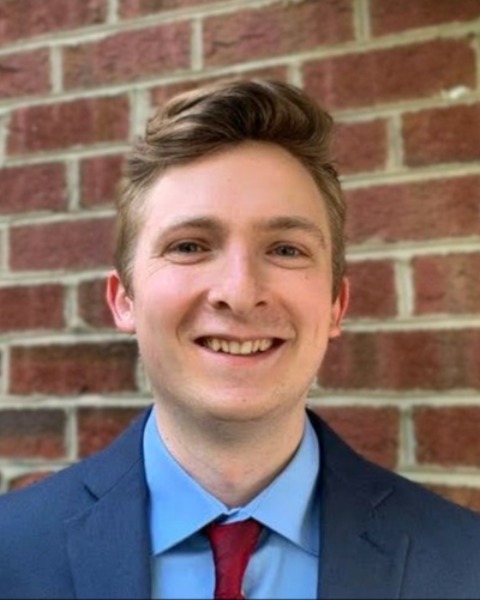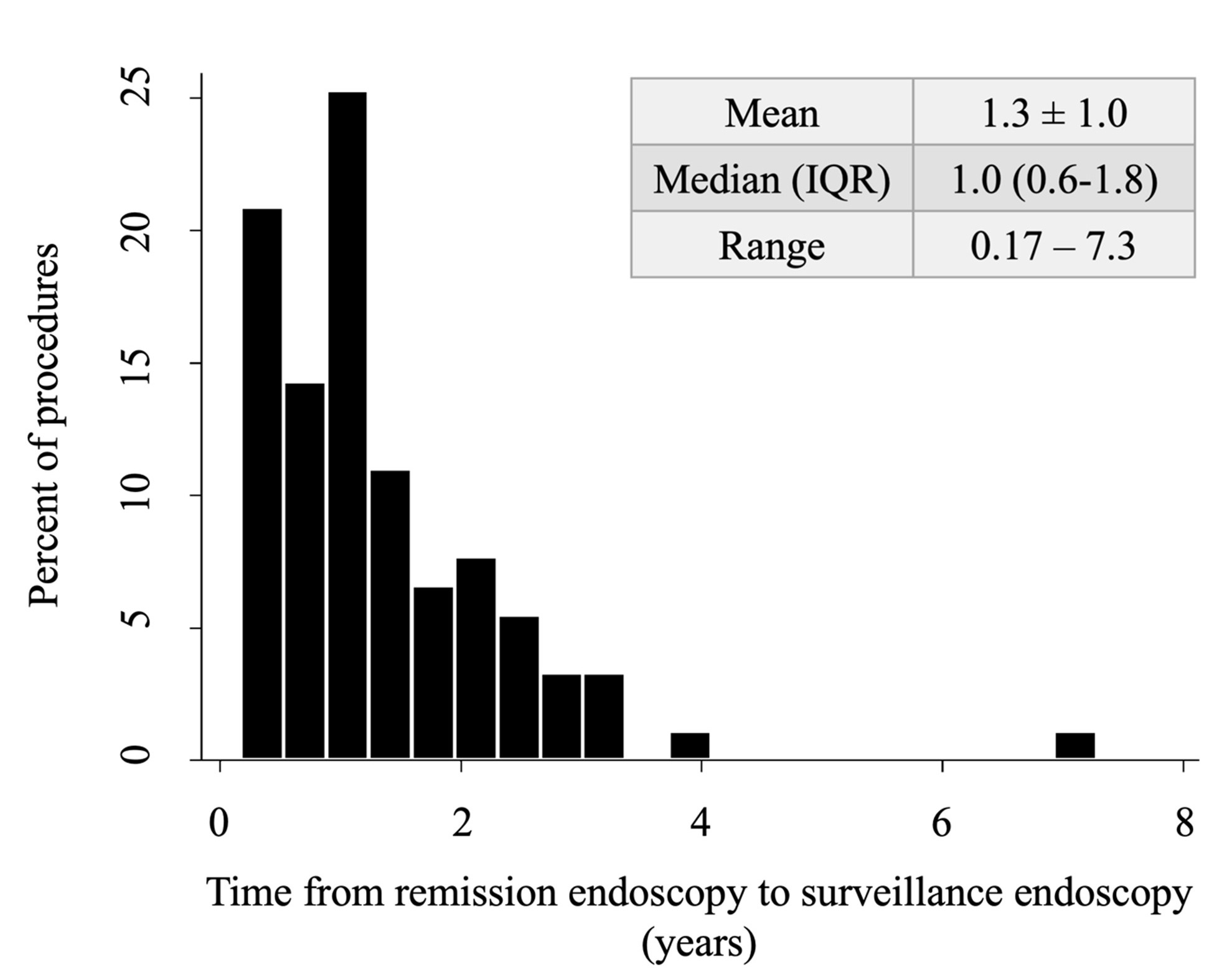Tuesday Poster Session
Category: Esophagus
P3899 - Variability in Time to Surveillance Endoscopy for Eosinophilic Esophagitis and Impact on Treatment Outcomes
Tuesday, October 29, 2024
10:30 AM - 4:00 PM ET
Location: Exhibit Hall E

Has Audio

Sean S. LaFata, BS
University of North Carolina at Chapel Hill School of Medicine
Chapel Hill, NC
Presenting Author(s)
Sean S. LaFata, BS, Tim S. Gee, BS, Cary C. Cotton, MD, MPH, Craig C. Reed, MD, MSCR, Evan S.. Dellon, MD, MPH, FACG
University of North Carolina at Chapel Hill School of Medicine, Chapel Hill, NC
Introduction: Patients with eosinophilic esophagitis (EoE) who achieve histologic and symptomatic remission require monitoring. However, little is known about the best timing for surveillance endoscopies or the effect of timing on outcomes. We aimed to assess variability in time to first remission surveillance endoscopy in EoE patients and determine if surveillance endoscopy timing is associated with disease outcomes.
Methods: In this retrospective cohort study, we included patients of any age diagnosed with EoE who achieved histologic remission (< 15 eos/hpf) while on stable EoE treatment and had ≥1 additional upper endoscopy with esophageal biopsy after remission. Clinical, histologic, and endoscopic data at baseline, remission, and surveillance endoscopy, including EoE Endoscopic Reference Scores (EREFS) and the Index of Severity for EoE (I-SEE), were extracted from medical records. We calculated time from remission endoscopy to first surveillance endoscopy, and assessed timing association with baseline and remission endoscopy features. We assessed outcomes at surveillance endoscopy by time to surveillance intervals (≤1 yr; 1-2 yrs; >2 yrs).
Results: The 91 patients who met inclusion criteria had substantial variability in time to first surveillance endoscopy (mean 1.3±1.0 years; median/IQR 1.0/0.6-1.8; range 0.17-7.3; Figure). While most patient demographics, baseline/remission EoE characteristics, and treatments were not associated with time to surveillance, a larger dilation size achieved during the remission endoscopy was correlated with longer time to first surveillance (R=0.36; p=0.03). EREFS at remission was also inversely correlated with time to surveillance (R=-0.21; p=0.07). Outcomes as measured by EREFS, I-SEE, and eosinophil count were generally similar whether surveillance was performed < 1 year, 1-2 years, or 2+ years after remission. However, numerically fewer patients who received surveillance EGD 2+ years after remission maintained histologic response (59% vs 78% at ≤1 yr and 82% at 1-2yrs; p=0.15) and more were likely to have ongoing EoE symptoms (47% vs 34% at ≤1 yr and 24% at 1-2 yrs; p=0.26).
Discussion: There is substantial variability in the time to first surveillance endoscopy in EoE patients who achieve disease remission, and this variability is not explained by most clinical and endoscopic features, except for dilation size achieved. An interval >2 years may lead to decreased histologic response or more symptoms.

Disclosures:
Sean S. LaFata, BS, Tim S. Gee, BS, Cary C. Cotton, MD, MPH, Craig C. Reed, MD, MSCR, Evan S.. Dellon, MD, MPH, FACG. P3899 - Variability in Time to Surveillance Endoscopy for Eosinophilic Esophagitis and Impact on Treatment Outcomes, ACG 2024 Annual Scientific Meeting Abstracts. Philadelphia, PA: American College of Gastroenterology.
University of North Carolina at Chapel Hill School of Medicine, Chapel Hill, NC
Introduction: Patients with eosinophilic esophagitis (EoE) who achieve histologic and symptomatic remission require monitoring. However, little is known about the best timing for surveillance endoscopies or the effect of timing on outcomes. We aimed to assess variability in time to first remission surveillance endoscopy in EoE patients and determine if surveillance endoscopy timing is associated with disease outcomes.
Methods: In this retrospective cohort study, we included patients of any age diagnosed with EoE who achieved histologic remission (< 15 eos/hpf) while on stable EoE treatment and had ≥1 additional upper endoscopy with esophageal biopsy after remission. Clinical, histologic, and endoscopic data at baseline, remission, and surveillance endoscopy, including EoE Endoscopic Reference Scores (EREFS) and the Index of Severity for EoE (I-SEE), were extracted from medical records. We calculated time from remission endoscopy to first surveillance endoscopy, and assessed timing association with baseline and remission endoscopy features. We assessed outcomes at surveillance endoscopy by time to surveillance intervals (≤1 yr; 1-2 yrs; >2 yrs).
Results: The 91 patients who met inclusion criteria had substantial variability in time to first surveillance endoscopy (mean 1.3±1.0 years; median/IQR 1.0/0.6-1.8; range 0.17-7.3; Figure). While most patient demographics, baseline/remission EoE characteristics, and treatments were not associated with time to surveillance, a larger dilation size achieved during the remission endoscopy was correlated with longer time to first surveillance (R=0.36; p=0.03). EREFS at remission was also inversely correlated with time to surveillance (R=-0.21; p=0.07). Outcomes as measured by EREFS, I-SEE, and eosinophil count were generally similar whether surveillance was performed < 1 year, 1-2 years, or 2+ years after remission. However, numerically fewer patients who received surveillance EGD 2+ years after remission maintained histologic response (59% vs 78% at ≤1 yr and 82% at 1-2yrs; p=0.15) and more were likely to have ongoing EoE symptoms (47% vs 34% at ≤1 yr and 24% at 1-2 yrs; p=0.26).
Discussion: There is substantial variability in the time to first surveillance endoscopy in EoE patients who achieve disease remission, and this variability is not explained by most clinical and endoscopic features, except for dilation size achieved. An interval >2 years may lead to decreased histologic response or more symptoms.

Figure: Figure
Disclosures:
Sean LaFata indicated no relevant financial relationships.
Tim Gee indicated no relevant financial relationships.
Cary Cotton: Pentax – Grant/Research Support.
Craig Reed indicated no relevant financial relationships.
Evan Dellon: Abbott – Consultant. AbbVie – Consultant. Adare/Ellodi – Consultant, Grant/Research Support. Aimmune – Consultant. Akesobio – Consultant. Alfasigma – Consultant. ALK – Consultant. Allakos – Consultant, Grant/Research Support. Amgen – Consultant. Aqilion – Consultant, Grant/Research Support. Arena/Pfizer – Consultant, Grant/Research Support. Aslan – Consultant. AstraZeneca – Consultant, Grant/Research Support. Avir – Consultant. Biorasi – Consultant. Calypso – Consultant. Celgene/Receptos/BMS – Consultant, Grant/Research Support. Celldex – Consultant. Dr. Falk Pharma – Consultant. Eli Lilly – Consultant. EsoCap – Consultant. Eupraxia – Consultant, Grant/Research Support. Ferring – Consultant, Grant/Research Support. GlaxoSmithKline – Consultant, Grant/Research Support. Gossamer Bio – Consultant. Holoclara – Consultant. Holoclara – Grant/Research Support. Invea – Consultant. Invea – Grant/Research Support. Knightpoint – Consultant. Landos – Consultant. LucidDx – Consultant. Meritage – Grant/Research Support. Miraca – Grant/Research Support. Morphic – Consultant. Nexstone Immunology/Uniquity – Consultant. Nutricia – Consultant, Grant/Research Support. Parexel/Calyx – Consultant. Phathom – Consultant. Regeneron Pharmaceuticals Inc. – Consultant, Grant/Research Support. Revolo – Consultant, Grant/Research Support. Robarts/Alimentiv – Consultant. Salix – Consultant. Sanofi – Consultant. Shire/Takeda – Consultant, Grant/Research Support. Target RWE – Consultant. Upstream Bio – Consultant.
Sean S. LaFata, BS, Tim S. Gee, BS, Cary C. Cotton, MD, MPH, Craig C. Reed, MD, MSCR, Evan S.. Dellon, MD, MPH, FACG. P3899 - Variability in Time to Surveillance Endoscopy for Eosinophilic Esophagitis and Impact on Treatment Outcomes, ACG 2024 Annual Scientific Meeting Abstracts. Philadelphia, PA: American College of Gastroenterology.
